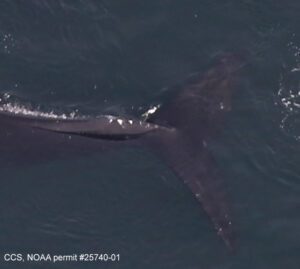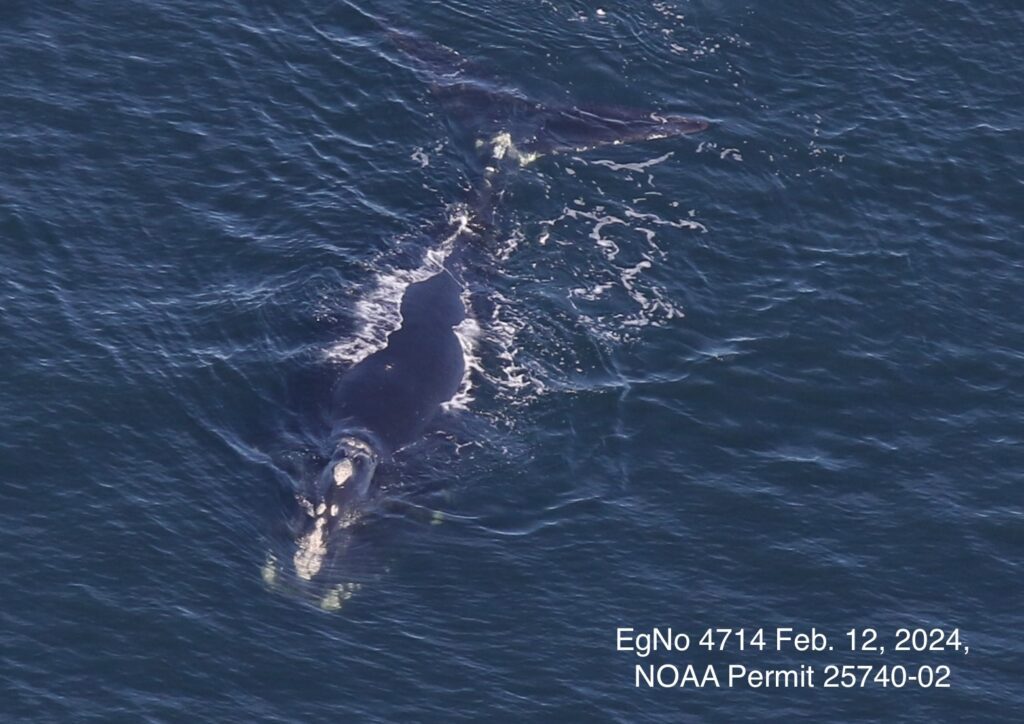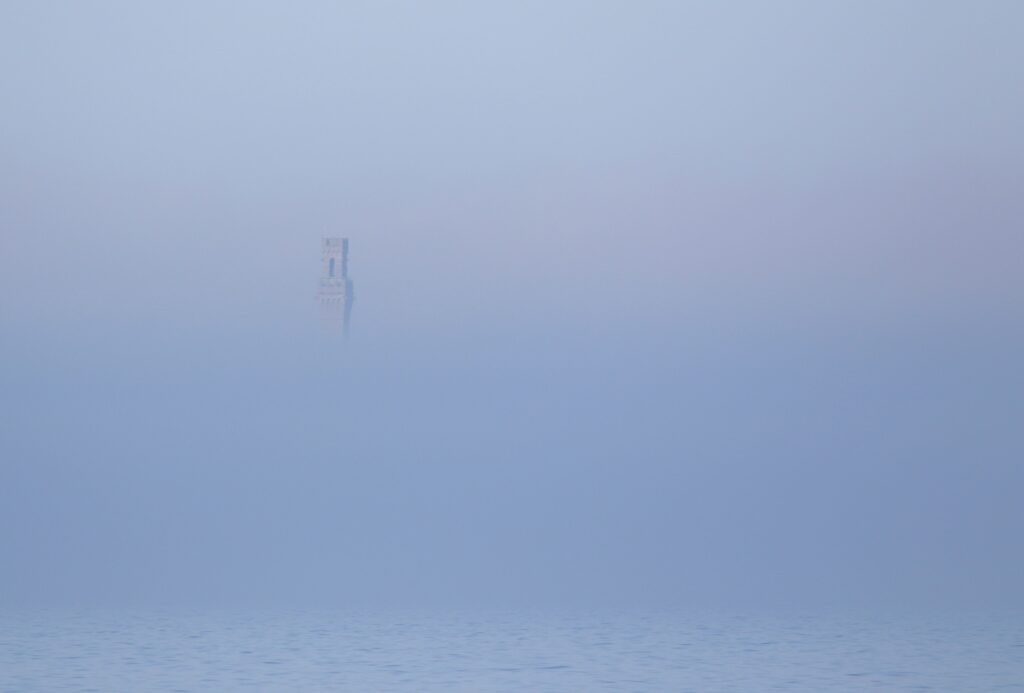Habitat Survey
February 12, 2024
After a brief delay picking up one of our observers, Amy, who was helping our aerial team troubleshoot their software, our vessel team set out ready to meet some of the new arrivals to Cape Cod Bay. Not too long after we were underway, Shreya, our habitat intern, spotted some blows off to the southeast and we headed over to see who was there. Our first sighting of the day turned out to be Aphrodite (#1701), who I had seen for the first time back in January. We initially spotted her with an additional whale, but as we came within range to ID the animals, the other slipped away before we could photograph them.
As we continued on our way, we spotted another couple blows off in the distance – which turned out to be a Surface Active Group (SAG) of three individuals exhibiting low-energy behaviors. The SAG, which was the first one I had ever seen, consisted of whales named Ruffian (#3530), Archipelago (#3370), and #3832. As we photographed and recorded behavioral observations, we heard the aerial team’s plane arrive overhead and circle as they collected their own data before returning to track.
Over the next couple hours, we sighted additional whales out on the water, but many were on deep dives and traveling in unclear directions, making them hard to track and ID. Luckily, after a few attempts, we came across a pair of whales and were able to ID them as Veer (#3060) and #2406. These animals were also on deep dives and were not feeding at the surface. Throughout the cruise Christy and Shreya deployed a number of plankton tows to assess the state of the food resource in the Bay, hoping to see the Pseudocalanus bloom that the whales are looking to eat.
As the afternoon went on, the wind died down and I was able to spot a fluke pop up around 4 kilometers from our position, which we were able to find in the glassy water and ID as #1715. Soon after, we spotted another cluster of bodies at the surface and moved over to them. The group of animals were identified as Sebastian (#4650), Domino (#3951), Goldfish (#4129), Champagne (#3904), and #4102. Two of these whales, Sebastian and Goldfish, were a bit harder to identify due to some new scars they had accrued since the last time they were spotted by CCS. Sebastian in particular had significantly more scarring on his peduncle, or the part where the fluke meets the tailstock, since 2022.
- #4650, Sebastian, in 2022 (left) and 2024 (right). NOAA permit No. 25740-01
Photos like the ones from this cruise are another reminder of the continued relevance of both vessel and aerial surveys as tools to track the life history of these endangered whales. We spotted one more individual, a whale named Cairn (#1409) who is around 40 years old, before we returned back to the dock, and are excited to know who else may arrive in the Bay in coming days.
– Morgan
Aerial Survey
February 12, 2024
Our last flight on Monday, Feb 12, was a challenging one to say the least. After being grounded for nearly two weeks while receiving reports of right whales in Cape Cod Bay, we were eager to finally fly again. While sitting on the runway preparing to take off, the software we use to collect data on our flight computer would not open. We tried troubleshooting for a few minutes until we decided it was an issue we likely wouldn’t be able to fix in the plane. We taxied back to the parking spot and waited for our back-up computer to arrive. It took some time to get the proper equipment set up with the back-up computer so that we would have GPS and everything running properly for data collection.
After an hour and a half delay, we took off, relieved to have seemingly sorted everything out and optimistic that it would be a smooth day with plenty of whales to see in the bay. That optimism was short-lived when I looked down at the computer at the end of our first track line and saw static on the screen. We broke track to circle and troubleshoot but could not get the computer working again. A short discussion led to the decision to go old-school and record all the data by hand which was less than ideal, but we were pretty desperate to get some good aerial coverage of Cape Cod Bay.
The day did improve from there, and while the hand recording took some getting used to, we got into a good rhythm. The weather was gorgeous and there were plenty of whales to see! At the beginning of our fifth track line, I spotted R/V Shearwater, and a closer look revealed our first right whale of the day just below the surface of the water. This turned out to be Aphrodite (#1701), who was among the first couple of whales we saw in Cape Cod Bay on January 24 from R/V Shearwater.
The next few hours entailed plenty of circling as we continued to see whales pop up around the eastern side of the bay. We witnessed a variety of different behaviors, from a Surface Active Group (SAG) to subsurface feeding to longer dives. The SAG was made up of #3629 and Domino (#3951), who were the two most-seen whales in Cape Cod Bay last year. Almost all of the other whales seen throughout the day are Cape Cod Bay regulars. Mantis (#1620) was first documented by CCS in 1986 and has visited Cape Cod Bay regularly ever since! We also re-sighted Archipelago (#3370), who was another one of the first whales seen in Cape Cod Bay along with Aphrodite. It was good to see that they’ve been sticking around for the last couple weeks, and maybe we’ll be seeing some more of them throughout the season. We were able to document new injuries and scars on #4714, who we last saw in Cape Cod Bay on April 14, 2023. Instances like this highlight the importance of our photo-identification work being able to tell us more about what happens to these whales in between sightings. All in all, we had 16 right whales seen by the plane.
Although this day did everything but go according to plan, we were relieved to have covered almost the entire bay. We are very much looking forward to having a smooth day to fly Cape Cod Bay in the near future to see who else is starting to show up!
– Annie
February 21, 2024 – R/V Shearwater
We had beautiful morning conditions as we prepared to set out on this week’s right whale cruise in Cape Cod Bay. Glassy seas and gray skies greeted us as we began scanning for tell-tale blows, hoping to take advantage of the morning calm. It wasn’t too long before our wishes were granted, and we spotted a pair of whales at the surface. These two individuals turned out to be Valkyrie (#3917) and #4102. Valkyrie was skim feeding separately when we first began documenting the pair, but they soon began to engage in a SAG together. Valkyrie rolled over a number of times, waving her pectoral flippers in the air. We also got a view of #4102’s white belly through the water, which looks like a greenish glow when seen from the boat. All of this activity made for great sampling conditions for our Habitat team, which took water samples in the path behind the two whales to filter for eDNA. Any skin cells obtained through this non-invasive sampling procedure as the whales shifted around could be used for DNA analysis back at the lab.
After moving on from this set of whales, we moved further offshore and spotted a few other individuals. However, these whales may have been traveling or feeding at depth as we had a difficult time tracking them and were not able to approach close enough to document and ID them. Just as we began to get a little frustrated, we spotted a blow a few kilometers off. This turned out to be #3391, a male right whale who was feeding just below the surface. After leaving him behind, we spotted another blow and made our way toward it. Not too long after adjusting our heading, the whale breached, launching over half of its body out of the water before falling back with a massive splash. I was stunned for a brief second, having just seen my first right whale breach, but quickly whipped out the camera and hoped to see another. As we moved closer and within range to document, the whale, which turned out to be Champagne (#3904) continued to breach 11 times, making for an incredible display.
 Right whale photo ID intern Morgan Pirozzi photographing Champagne (#3904) (Courtesy of Marilyn Marx, New England Aquarium)
Right whale photo ID intern Morgan Pirozzi photographing Champagne (#3904) (Courtesy of Marilyn Marx, New England Aquarium)
We came across one final group of whales in a SAG, this time with at least 4 individuals participating. Some of them spent a large majority of time underwater, only surfacing to breathe once or twice during our observations. Others spent more time at the surface, slapping the water with their flippers or rolling onto their backs. These whales were Sebastian (#4650) and #2406, who we had seen on our last cruise, as well as Seadragon (#3680) and #3629. After recording behaviors from this SAG, the group seemed to disperse and we departed and headed back to dock after another successful day on the water.
– Morgan
Aerial Survey
February 25, 2024
We took off at 8 am on a beautiful Sunday morning aiming to tackle our longest field day so far this season. We hoped to completely survey Cape Cod Bay then possibly fly additional survey tracklines along the eastern outer shore of Cape Cod if we finished up the bay with daylight to spare. Sighting conditions were beautiful which made spotting the first few right whales on our initial three tracklines pretty simple.
Just as we started our fifth trackline, we spotted a right whale feeding just below the water’s surface about 1.5 miles off the beaches of North Truro. We broke from our track to document this individual and quickly realized that there were actually many right whales feeding in the area. Not only that but we were also able to see multiple patches of white water and whale blows about two miles south along our next trackline suggesting that there were multiple groups of right whales SAGing at the surface. We documented the whales feeding off North Truro as efficiently as possible and found that most of them were individuals that we were seeing for the first time this season. Many of these whales had been observed by other aerial teams feeding near shipping lanes in the Great South Channel just two weeks earlier, so we were relieved to see that they’ve safely arrived in Cape Cod Bay over the last few days.
After wrapping up documentation of this group, we moved onto what we colloquially referred to as “SAG City,” four different groups of SAGing right whales within a few miles on the same latitude (or as Annie proclaimed it: ”SAGitude”). The largest of these was a SAG comprised of EGNO 4192, 4640 “Wishbone,” 4650 “Sebastian” & 4042 “Martini.” Wishbone was the focal female in this SAG being pursued by males by Sebastian, Martini & #4192 with plenty of high-energy, aggressive behaviors generating a lot of white water and splashing.
We continued to document many more right whales as we worked our way south in the bay, though most of these were taking long deep dives, staying below the surface for 10-15 minutes at a time. One of these whales was #4340 Pilgrim, named for the Pilgrim Power in Plymouth near where she was first sighted as a days-old calf in 2013. Unfortunately, her one-year-old daughter was found dead off Savannah, Georgia just 10 days ago.
We ended up only covering 12 out of 15 of our Cape Cod Bay tracklines but documented a season high 50 right whales! It seems like we have more and more right whales entering the bay each day so we’re likely to have even more next time we take to the skies!
– Ryan
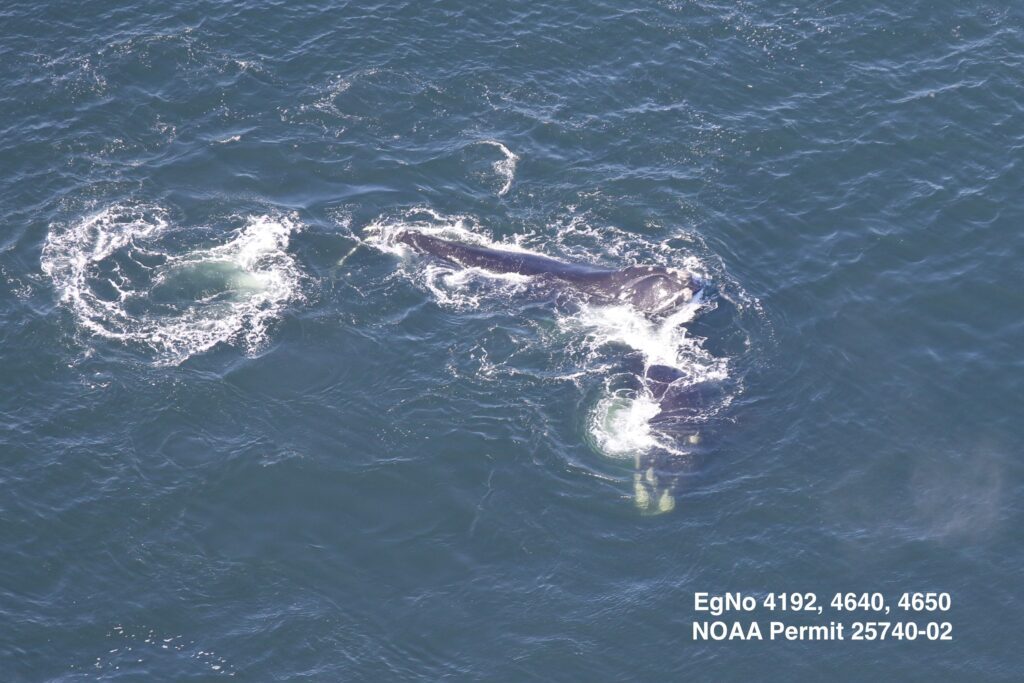 SAG comprised of EGNOs #4192, #4640 Wishbone & #4650 Sebastian
SAG comprised of EGNOs #4192, #4640 Wishbone & #4650 Sebastian
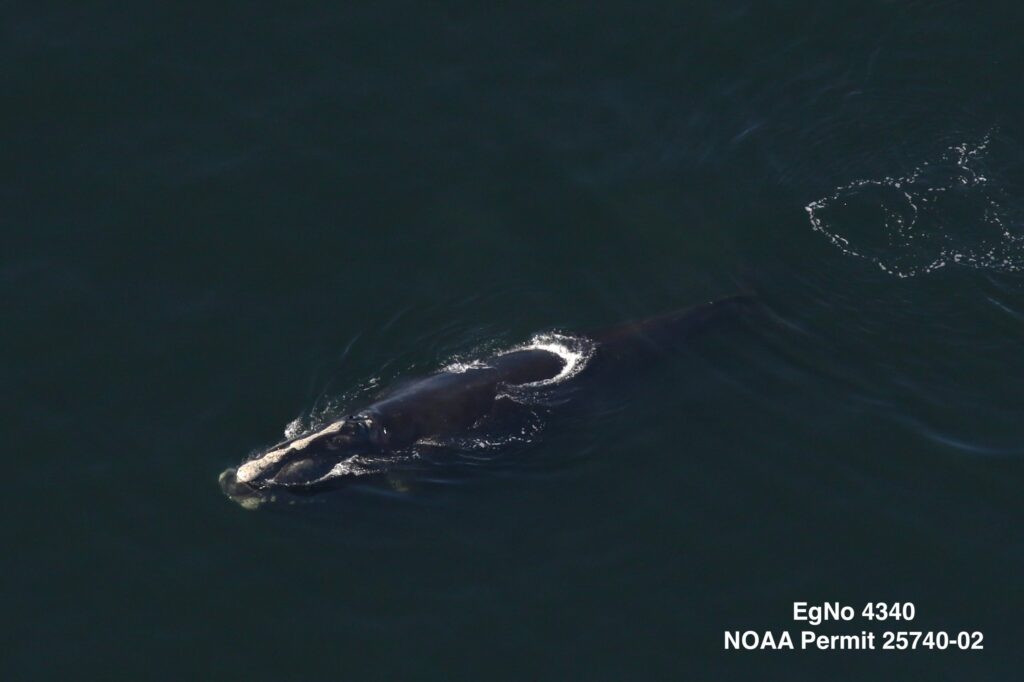 EgNo #4340 Pilgrim, swimming at the surface shortly before diving
EgNo #4340 Pilgrim, swimming at the surface shortly before diving
February 27, 2024 – R/V Shearwater
Waking up bright and early on the morning of this cruise meant being greeted by a thick layer of fog laying low around the streets of Provincetown. Despite the limited visibility, our team loaded up the boat and set off hoping for the fog to burn off before too long. The morning was definitely not ideal for sighting whales, so we headed to our first regular sampling station to collect some water and plankton samples and then transited further south into the bay, where visibility was slightly better. As the sun rose higher, we saw the top of the Pilgrim Monument peeking out of the fog – with the rest of the obstructing weather soon dissipating
With the fog burned off, we all scoured the water’s surface for any possible disturbances and a bit of a friendly competition sprung up among us observers to see who would spot the first right whale of the day. Much to my disappointment, our data manager and aerial observer, Ryan, won out and spotted a subsurface feeding whale, which turned out to be a mystery whale! This whale had been spotted previously in Cape Cod Bay and is known to CCS observers, but has not yet been matched with other existing whales in our catalog, so it was great to get some vessel-based documentation of them. Nearby was a juvenile whale known as #4970, also subsurface feeding. #4970 is the second known calf of a whale named Pico (#3270) and was born in 2019.
 EgNo 4970, mouth open, sub surface feeding. NOAA Permit 25740-02
EgNo 4970, mouth open, sub surface feeding. NOAA Permit 25740-02
After a bit of a slow start, the sightings began to pick up quickly. We came across two individuals together not long after, which turned out to be Silt (#1817) and #4712. These two gave us some great looks and pictures before we moved on to a bigger surface active group, or SAG. This group consisted of five individuals with attention focused primarily on a female called #4550, a younger whale and Cape Cod regular born in 2015. The other individuals in the group were #3712, #4192, #3742, and Havana (#3460). Four of these whales had been spotted by our aerial team in previous days, so it was nice to see that they were sticking around a bit longer. This group was very active in their following of #4550, with lots of rolling and splashing seen as they maneuvered around each other. After taking lots of behavioral notes and photo documentation, we began to transit back towards the dock in anticipation of higher winds in the afternoon. On our way back, we spotted a handful of whales scattered across the bay, but only had time to approach one more who was relatively close to our heading. This whale was identified as Hyphen (#2681), known for a distinctive hyphen-like scar across the top of his coaming. Unfortunately, we only had time for one surfacing before he dove back down and out of sight. With this final goodbye, we bundled up against the wind and returned to Provincetown.
– Morgan

